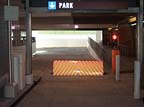Delayed Exit No Entrance

Such delayed egress devices, in a diversity of configurations, let building occupants somewhat easily leave the facility under any number of situations including emergencies. The equipment fits well where the exit door may be near public areas or where shoplifters could leave without visibly bypassing a cashier or security officer.
The basic element of such devices is a panic bar, the less flexible piece of equipment which could also locally and/or remotely alarm when a person pushes the bar to exit a seemingly locked door.
With delayed exit designs, when the bar is pushed for a few seconds an alarm sounds to begin a countdown to unlock the door, usually in 15 seconds. Station controls can vary from a rest keyswitch or reset & sustained bypass with lock status LED as well as digital keypad and even remote annunciator. The device connects to central monitoring and/or interfaced to a security management or video system.
Delayed egress locking must comply with a variety of building and fire life safety codes such as National Fire Protection Agency 101 Life Safety Code as well as local building codes. Most professional devices on the market meet IBC International Building Code, IFC International Fire Code, UBC Uniform Building Code, CBC California Building Code and SBC Standard Building Code. In addition to NFPA 101, devices need to address NFPA 1, UFC Uniform Fire Code.

Requirements vary
Typically, delayed egress is not permitted in assembly occupancies such as stadiums. They must be connected to the building fire alarm system. There is a fail-safe feature in which the door unlocks when there is a loss of power or fire. Authorities with jurisdiction look to make sure there is only one delayed egress door along a path of exit as well as signage at the delayed egress side of the door.Recent trends include smaller profiles and lower cost. One example: the Mini Delayed Egress EMLock from SDC Security Door Controls of Westlake Village, Calif. For this new product, there is a subdued alarm tone with two distinct tones so a person can realize the alarm has been activated and then know the door has been released.
Another type of specialized access control aims not at delaying egress but instead to eliminating the entrance of vehicles. Corrections facilities, federal rules hardening government buildings here and abroad as well as terrorism threats have spurred the sales of barriers and bollards.
When Delta Scientific of Valencia, Calif., this last spring shipped the first of 541 Delta DSC501 barriers to the U.S. Air Force, Delta’s David Dickinson was telling the media that "from amusement parks to museums, we are installing anti-terrorist vehicle barriers in places none of us would have imagined prior to 9-11."
Automatic Control Systems of New York also has numerous installations beyond embassies. For example, the firm’s RSB-71 High-Security Road Blocker Barrier typically controls access to critical areas such as: governmental buildings, embassies, police stations and police barracks. But it also is popular at airports such as the operation in Palm Springs, Calif. Harvard University, as another example, has the firm’s RSB-73 H&E High-Security Road Blocker Barrier to control access.
Looking for a reprint of this article?
From high-res PDFs to custom plaques, order your copy today!






